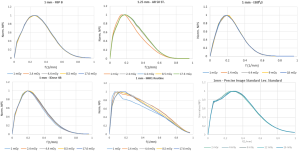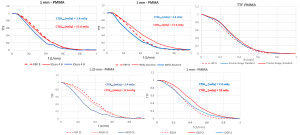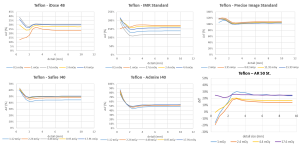Noise Properties
As illustrated in Figure 4, the normalised NPS profiles obtained with FBP and 2nd and 3rd generation IR, as well as the Deep Learning Reconstruction Algorithm, are presented.The transition from FBP to iDose and IMR of increasing strength has been shown to not only reduce the noise level, but also shift the spectrum towards lower frequencies. The shift of the peak frequency was found to be minimal for 2nd generation IR (iDose, on average Df < -0.05 mm-1), however, a substantial increase was observed for 3rd generation IR (IMR, Medium Df = -0.15 mm-1), which exhibited a strong dependency from CTDI values.
Conversely, other IR algorithms exhibited only minor frequency shifts, which were more evident for 2nd generation Safire and Asir-V (Df = -0.05 mm-1, -0.07 mm-1, respectively) compared to 3rd generation Admire (Df = -0.05 mm-1), with minimal dependency from CTDI values.
Conversely, the Deep Learning Algorithm exhibited a tendency to emulate the behaviour of the FBP model, characterised by a marginal increase in peak frequency (Df = 0.05 mm-1) without any significant impact on average frequency. This behaviour demonstrated no correlation with CTDI values.

Spatial Resolution
Fig. 5 reports examples of calculated TTF profiles for Teflon Inserts. The transition from FBP to iDose and IMR of increasing strength has been shown to produce an improvement in spatial resolution. This improvement is found to be negligible for 2^(nd) generation IR. Conversely, a substantial enhancement is observed for 3^(rd) generation IR. In both cases, a reduction in CTDI value results in a concomitant reduction in TTF values. In a similar manner, other 2nd generation IR algorithms (Safire and Asir-V) exhibited slight improvement in spatial resolution compared to 3rd generation Admire, which demonstrated a trend more similar to IMR results. Once again, a reduction of CTDI value resulted in a reduction of TTF values.
Conversely, the Deep Learning Algorithm exhibited a small improvement in TTF values, with limited dependency from CTDI values.

Fig 6 shows the same comparison related to a PMMA insert. The IR algorithms demonstrate analogous behaviour observed in Teflon inserts, exhibiting a general decline in performance that results in frequent lower TTF values when compared to FBP, notably at low CTDI values.
Concurrently, the results obtained from the Deep Learning Reconstruction algorithm do not demonstrate this behaviour, leading to a reduced dependence of spatial resolution on contrast, similar to that observed for CTDI values.

Detectability Index
Figure 7 and 8 show detectabilty index improvent from FBP related to Teflon and PMMA inserts, respectively.
2nd generation IR algorithms have been found to show slight improvement in detectability index (between 30% and 50%), a finding similar to that of the Admire reconstruction algorithm. Conversely, IMR has been shown to produce the highest improvement, reaching a value of up to 200%. Furthermore, these algorithms, in a manner analogous to the findings of TTF, demonstrate a dependency on both contrast and CTDI, exhibiting varying degrees of magnitude.
In contrast, the Deep Learning Algorithm displays consistent enhancement in d prime values for both PMMA and Teflon inserts (between 110 and 120%) with only marginal dependency on CTDI values and contrast.

